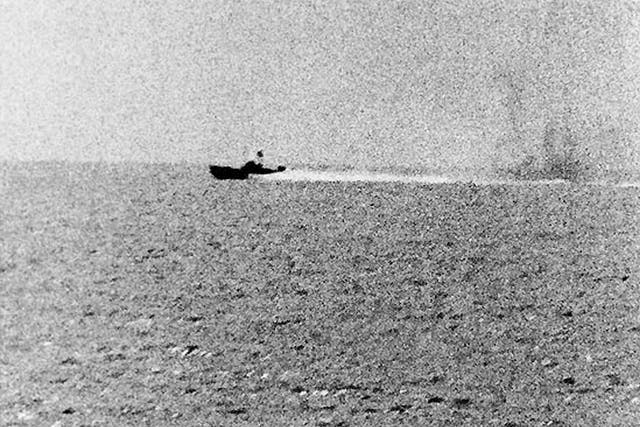

After World War II, France reoccupied its former colonies in Southeast Asia, only to be kicked out again by the forces of Communist leader Ho Chi Minh. In 1954, as the conflict wound down, the world’s powers reached an agreement to temporarily divide Vietnam in two, with all Ho supporters going north and all French supporters going south. Elections were supposed to reunite the country within a couple of years, but the United States opposed them over concerns that Ho would win the presidency. Instead, it propped up the corrupt and authoritarian government of Ngo Dinh Diem.
South Vietnam “was essentially the creation of the United States,” the Defense Department would later admit in the Pentagon Papers. Within a few years, a rebellion had sprung up against Diem, aided by Ho’s forces in the north, who oversaw a string of assassinations against non-Communist village leaders.
Under presidents Harry S. Truman, Dwight D. Eisenhower, John F. Kennedy and Lyndon B. Johnson, the United States gave France—and then South Vietnam—economic aid and weapons with which to fight the Communist rebels. It also sent over more and more military advisors, some of whom participated in raids despite ostensibly being there only for self-defense.
As part of one such covert operation, the United States trained and directed South Vietnamese sailors to bombard radar stations, bridges and other targets along the North Vietnamese coast. Meanwhile, U.S. warships such as the Maddox conducted electronic espionage missions in order to relay intelligence to South Vietnam. The rebels continued gaining ground, however, both before and after U.S. officials sanctioned a coup in which Diem was murdered.
At this point, U.S. involvement in Vietnam remained largely in the background. But in the pre-dawn hours of July 31, 1964, U.S.-backed patrol boats shelled two North Vietnamese islands in the Gulf of Tonkin, after which the Maddox headed to the area. As it cruised along on August 2, it found itself facing down three Soviet-built, North Vietnamese torpedo boats that had come out to chase it away. The Maddox fired first, issuing what the U.S. authorities described as warning shots. Undeterred, the three boats continued approaching and opened up with machine-gun and torpedo fire of their own. With the help of F-8 Crusader jets dispatched from a nearby aircraft carrier, the Maddox badly damaged at least one of the North Vietnamese boats while emerging completely unscathed, except for a single bullet that lodged in its superstructure.
The following day, the U.S. destroyer Turner Joy was sent to reinforce the Maddox, and U.S.-backed raids took place against two additional North Vietnamese defense positions. Then, on August 4, the Maddox and Turner Joy reported that they had been ambushed, with enemy boats firing 22 torpedoes at them. In response, President Johnson ordered air strikes against North Vietnamese boat bases and an oil storage depot.
Uncover the Bay of Tonkin Incident on the shores of North Vietnam. U.S. warships retaliated against attacks from the Vietnamese by sinking two of their ships.
Following months of secret U.S. bombings on Communist bases, American ground troops were deployed to northern Cambodia on April 28, 1970.
The conflict in Vietnam took root during an independence movement against French colonial rule and evolved into a Cold War confrontation.
“Aggression by terror against the peaceful villagers of South Vietnam has now been joined by open aggression on the high seas against the United States of America,” he said that evening in a televised address. He also requested a congressional resolution, known as the Gulf of Tonkin Resolution, which on August 7 passed unanimously in the House and with only two dissenting votes in the Senate, essentially giving him the power to wage war in Southeast Asia as he saw fit.
Throughout these hectic few days, the Johnson administration asserted that the destroyers had been on routine patrol in international waters. In actuality, however, the destroyers were on an espionage mission in waters claimed by North Vietnam. The Johnson administration also described the two attacks as unprovoked; it never disclosed the covert U.S.-backed raids taking place.
Another problem: the second attack almost certainly never occurred. Instead, it’s believed that the crewmembers of the Maddox mistook their own sonar’s pings off the rudder for North Vietnamese torpedoes. In the confusion, the Maddox nearly even fired at the Turner Joy. Yet when U.S. intelligence officials presented the evidence to policy makers, they “deliberately” omitted most of the relevant communications intercepts, according to National Security Agency documents declassified in 2005.
“The overwhelming body of reports, if used, would have told the story that no attack had happened,” an NSA historian wrote. “So a conscious effort ensued to demonstrate that an attack occurred.” The Navy likewise says it is now “clear that North Vietnamese naval forces did not attack Maddox and Turner Joy that night.”
In private, Johnson himself expressed doubts about the Gulf of Tonkin incident, reportedly telling a State Department official that “those dumb, stupid sailors were just shooting at flying fish!” He also questioned the idea of being in Vietnam at all. “A man can fight if he can see daylight down the road somewhere,” he told a senator in March 1965. “But there ain’t no daylight in Vietnam, there’s not a bit.” Yet even as he said that, he was committing the first ground combat units and initiating a massive bombing campaign.
The United States would not withdraw from Vietnam until 1973, by which time a disillusioned Congress had voted to repeal the same Gulf of Tonkin Resolution it had so overwhelmingly supported just a few years earlier.
See the Vietnam War unfold through the gripping firsthand accounts of 13 brave men and women forever changed by their experiences.